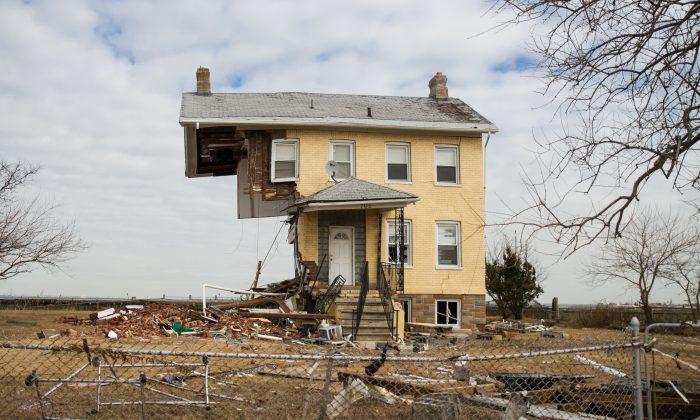Americans on the Gulf and East coasts, in Tornado Alley, living in the shadow of Mississippi and Missouri river levees, or threatened by Western wildfires like the one now raging in Yosemite are all learning a harsh lesson. Preparing for climate change is costly. But not preparing is catastrophically expensive.
Eight years after Hurricane Katrina, nearly 100,000 people still haven’t returned to their New Orleans homes; good jobs are lacking and public housing is mostly gone. One year after Hurricane Sandy, poor towns like Union Beach, N.J.—which saw half of its homes damaged or uninhabitable—don’t have the means to recover, while rich towns like Mantoloking, N.J., have wrangled millions in federal funds to build massive seawalls, dubious protection against the rising seas and fiercer hurricanes expected from climate change.
So how do we pay in advance to defend communities against escalating extreme weather? It’s a thorny question. But here are some logical answers:
Scientifically assess dangers ahead: North Carolina passed a law last year that wished away climate change. It requires all future sea rise estimates be based on historical data, rather than on scientific projections of a 3-foot rise by 2100. Sadly, ignoring climate science only profits coastal developers, while leaving homeowners and municipalities defenseless against worsening storms. To prepare for the Sandys of tomorrow, government must stop denying global warming and do thorough national, regional, and local scientific assessments of worst-case climate change damage scenarios and the best precautions against them.
Article Continues after the discussion. Vote and comment
[tok id=90aef062c08347e52af0d02fa0ef4062 partner=1966]Opt for economical solutions: Politicians like New York City’s Mayor Michael Bloomberg cater to developers by proposing billion dollar seawalls, but a storm surge or river rise that tops a wall or levee by a single inch makes those barriers useless. Communities need to do cost-benefit analyses to compare climate change solutions so they can choose the best—often low- and mid-priced—options. Rather than building costly seawalls, for example, towns might choose to convert beachfronts into passive recreation zones, such as wetlands and parks.
Climate change risk zoning: Climate change is here and getting worse. Acknowledging that, we need better building codes in communities prone to tornadoes, hurricanes, and wildfires, and we need to federally assist municipalities in developing zoning maps that include up-to-date FEMA estimates for sea level rise, and future storm surges. Where necessary, government, business, and citizens need to equitably shoulder the economic hardship resulting from the surrender of valuable waterfront real estate to the encroaching sea.
Home buying climate change caveats: Property purchase agreements need to be updated to warn those buying in areas of high climate-change risk—where wildfires or floods are likely. It’s just common sense to inform people and let them make their own judgments on where to live.
One strike and you’re out: Want to build a McMansion on the beach with a front-row seat for the next Katrina? It’s your legal right, if you can afford federal flood insurance or self-insure. But if your property is destroyed by a climate change disaster, and you’re compensated, you shouldn’t be allowed to rebuild there again and again, and be compensated by insurers for repeated destruction.
Climate change risk-taker tax: If you decide to build in a high-risk zone, you should also be assessed a municipal climate change tax for putting others at risk, such as first responders who will have to rescue you in a disaster. Your decision to build in a high-risk zone also prevents municipalities from making the economically sensible choice to retreat and withdraw vulnerable public services such as roads and utilities from that area.
These may be good ideas, but they’re unlikely to get done. Current federal policy is to do nothing, which means Nature will take care of it—likely with horrific climate disasters, bringing death, destruction, insurance industry bankruptcy, state and community insolvency, and huge damage to the federal economy.
We need to face the truth: preparing now will be costly, but waiting will be devastatingly costly. Unfortunately, anyone who watched the Katrina or Sandy recoveries knows that it’s very hard to overcome public and private shortsightedness, denial, inertia, greed, and stupidity. While I’m an optimist, I don’t hold out much hope.
Andrew J. Willner, former executive director and baykeeper at NY/NJ Baykeeper, is a sustainability consultant and has been a leading activist in the New York/New Jersey Bioregion for over 25 years. See more solutions at: www.andrewwillner.com ©2013 www.bluerdigepress.com.

Friends Read Free